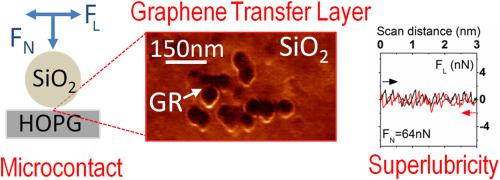Carbon ( IF 10.5 ) Pub Date : 2021-08-31 , DOI: 10.1016/j.carbon.2021.08.071 Renato Buzio 1 , Andrea Gerbi 1 , Cristina Bernini 1 , Luca Repetto 2 , Andrea Vanossi 3, 4

|
Colloidal probe Atomic Force Microscopy allows to explore sliding states of vanishing friction, i.e. superlubricity, in mesoscopic graphite contacts. Superlubricity is known to appear upon formation of a triboinduced transfer layer, originated by material transfer of graphene flakes from the graphitic substrate to the colloidal probe. Previous studies suggest that friction vanishes due to crystalline incommensurability at the newly formed interface. However this picture still lacks several details, such as the roles of the tribolayer roughness and of loading conditions. Hereafter we gain deeper insight into the tribological response of micrometric silica beads sliding on graphite under ambient conditions. We show that the tribotransferred flakes behave as lubricious nanoasperities with a twofold role. First, they decrease the silica-graphite true contact area, in fact causing a breakdown of adhesion and friction by one order of magnitude. Second, they govern mechanical dissipation through the specific energy landscape experienced by the topographically-highest triboinduced nanoasperity. Remarkably, such contact junctions can undergo a load-driven atomic-scale transition from continuous superlubric sliding to dissipative stick-slip, that agrees with the single-asperity Prandtl-Tomlinson model. Superlubricity in mesoscopic silica-graphite junctions may therefore arise from the load-controlled competition between interfacial crystalline incommensurability and contact pinning effects at one dominant nanoasperity.
中文翻译:

通过摩擦诱导纳米接触实现石墨超润滑性
胶体探针原子力显微镜允许探索在介观石墨接触中摩擦消失的滑动状态,即超润滑性。已知超润滑性出现在摩擦诱导转移层的形成时,源自石墨烯薄片从石墨基底到胶体探针的材料转移。先前的研究表明,由于新形成的界面处的晶体不可公度,摩擦力消失了。然而,这张图片仍然缺乏一些细节,例如摩擦层粗糙度和加载条件的作用。此后,我们更深入地了解了测微二氧化硅珠在环境条件下在石墨上滑动的摩擦学响应。我们表明摩擦转移的薄片表现为具有双重作用的润滑纳米凹凸。第一的,它们减少了二氧化硅-石墨的真实接触面积,实际上导致附着力和摩擦力下降一个数量级。其次,它们通过地形上最高的摩擦诱导纳米粗糙所经历的特定能量图来控制机械耗散。值得注意的是,这种接触结可以经历从连续超润滑滑动到耗散粘滑的负载驱动的原子级转变,这与单粗糙度 Prandtl-Tomlinson 模型一致。因此,介观二氧化硅 - 石墨结中的超润滑性可能源于界面晶体不可公度和一种主要纳米粗糙的接触钉扎效应之间的负载控制竞争。它们通过地形上最高的摩擦诱导纳米粗糙所经历的特定能量图来控制机械耗散。值得注意的是,这种接触结可以经历从连续超润滑滑动到耗散粘滑的负载驱动的原子级转变,这与单粗糙度 Prandtl-Tomlinson 模型一致。因此,介观二氧化硅 - 石墨结中的超润滑性可能源于界面晶体不可公度和一种主要纳米粗糙的接触钉扎效应之间的负载控制竞争。它们通过地形上最高的摩擦诱导纳米粗糙所经历的特定能量图来控制机械耗散。值得注意的是,这种接触结可以经历从连续超润滑滑动到耗散粘滑的负载驱动的原子级转变,这与单粗糙度 Prandtl-Tomlinson 模型一致。因此,介观二氧化硅 - 石墨结中的超润滑性可能源于界面晶体不可公度和一种主要纳米粗糙的接触钉扎效应之间的负载控制竞争。这与单粗糙度 Prandtl-Tomlinson 模型一致。因此,介观二氧化硅 - 石墨结中的超润滑性可能源于界面晶体不可公度和一种主要纳米粗糙的接触钉扎效应之间的负载控制竞争。这与单粗糙度 Prandtl-Tomlinson 模型一致。因此,介观二氧化硅 - 石墨结中的超润滑性可能源于界面晶体不可公度和一种主要纳米粗糙的接触钉扎效应之间的负载控制竞争。











































 京公网安备 11010802027423号
京公网安备 11010802027423号